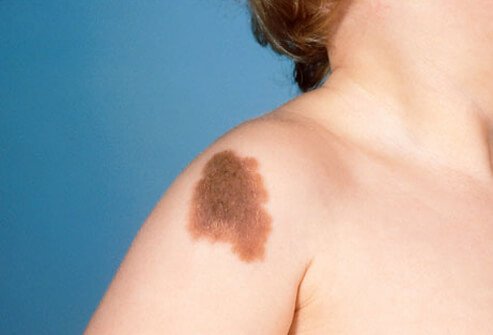Pigmented nevi (moles) are growths on the skin that usually are flesh-colored, brown or black. Moles can appear anywhere on the skin, alone or in groups. Moles occur when cells in the skin grow in a cluster instead of being spread throughout the skin. Moles may darken after exposure to the sun, during the teen years and during pregnancy.
What Causes Birthmarks?
The cause of most birthmarks is unknown. Most birthmarks are not inherited. Many folk tales and myths exist about the causes of birthmarks, but none of these stories have been proven to explain the true causes of birthmarks.
Do Birthmarks Need to Be Treated?
Most birthmarks need no treatment. They often fade as a child grows older. However, some birthmarks may need treatment because of their location. For example, a raised birthmark near a child’s eye may interfere with his or her ability to see. In rare cases, birthmarks are associated with other conditions, such as growths on the liver, lungs, stomach, or intestine.
Types of Birthmarks
There are two main categories of birthmarks — red marks and pigmented birthmarks.
Red birthmarks are colored, vascular (having to do with blood vessels) skin markings that develop before or shortly after birth. Pigmented birthmarks are skin markings that are present at birth. Their color ranges from brown or black to bluish or blue-gray.
Types of Pigmented Birthmarks
mongolian spot usually are bluish and look like bruises. They often appear on the buttocks and/or lower back, but they sometimes also appear on the trunk or arms. The spots are seen most often in people who have darker skin.
Pigmented nevi (moles) are growths on the skin that usually are flesh-colored, brown or black. Moles can appear anywhere on the skin, alone or in groups. Moles occur when cells in the skin grow in a cluster instead of being spread throughout the skin. Moles may darken after exposure to the sun, during the teen years, while taking some birth control pills, and during pregnancy.


Congenital nevi are moles that are present at birth. These birthmarks have a slightly increased risk of becoming skin cancer, depending on their size. Larger congenital nevi have a greater risk of developing skin cancer than do smaller congenital nevi. All congenital nevi should be examined by a health care provider and any change in the birthmark should be reported.
Cafe-au-lait spots are light tan or light brown spots that are usually oval in shape. They usually appear at birth but may develop in the first few years of a child’s life. Cafe-au-lait spots may be a normal type of birthmark, but the presence of several cafe-au-lait spots larger than a quarter may occur in neurofibromatosis (a genetic disorder that causes abnormal cell growth of nerve tissues) and other conditions.
What Causes Pigmented Birthmarks?
The cause of pigmented birthmarks is not known. However, the amount and location of melanin (a substance that determines skin color) determines the color of pigmented birthmarks.
What Are the Symptoms of Pigmented Birthmarks?
Symptoms of pigmented birthmarks include skin that is abnormally dark or light, or bluish, brown, black or blue-gray in color. Discolorations of the skin may vary in size and can be smooth, flat, raised or wrinkled. Pigmented birthmarks may increase in size, change colors, become itchy, and may occasionally bleed. If they do, they should be seen by a dermatologist as they may require a biopsy
How Are Pigmented Birthmarks Diagnosed?
In most cases, health care professionals can diagnose birthmarks based on the appearance of the skin. If a mole exhibits potentially cancerous changes, a biopsy may be performed.

